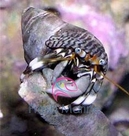Anemone Crab - Neopetrolisthes ohshimai - Porcelain Anemone Crab

Taxonomy: Anemone Crab belongs to the Kingdom Animalia, Phylum Arthropod, Class Crustacea, Order Decapoda, Family Porcellanidae, Genus Neopetrolisthes and Species ohshimai.
Scientific names: The scientific name of Anemone Crab is Neopetrolisthes ohshimai.
Other common names: Anemone Crab is also called as Porcelain Crab.
Origin or natural range: Neopetrolisthes ohshimai is found in the Indo-Australian region, Hawaii, Indo-Pacific region including Indonesia.
Size: Anemone Crab may grow up to around one inch.
Color: Neopetrolisthes ohshimai occurs in brown, white and orange colors.
Compatibility: Anemone Crab is aggressive towards the other crabs while, it is non-aggressive towards the rest of the marine aquarium invertebrates.
Habit & Habitat:
- Neopetrolisthes ohshimai shares a symbiotic relationship with many Anemones and lives in pair between the Anemones’ tentacles. The Anemones protect Anemone Crab from its predators by providing shelter to it in the exchange for food that crab arranges for them.
- Also, Neopetrolisthes ohshimai cleans the Anemone it dwells with by eating the food scraps and mucus off the Anemone’s body surface.
- Anemone Crab is able to live with Anemones because it has a coating of mucus on its body which is resistant to the Anemones’ sting.
- Neopetrolisthes ohshimai does not want to allow clownfish to stay with the Anemone the crab lives with. Anemone Crab uses its claws to scare away the clownfish in its habitat. Clownfish, however, win the battle ultimately.
- If not with Anemone then Neopetrolisthes ohshimai lives in its own shed out shell.
- Anemone Crab, though small in size, is quite hardy and has porcelain like shell.
- Neopetrolisthes ohshimai has long antennae and three pair of legs.
- The head of Anemone Crab is joined with its thorax. The thorax is covered with a shell like covering called carapace.
- Neopetrolisthes ohshimai also contracts its abdomen and tail leaving exposed only the legs and the head of crab.
- The Carapace of Anemone Crab is generally white in color with beautiful red or brown spots on it.
- Neopetrolisthes ohshimai exfoliates its hard exoskeleton in order to grow. The process of exfoliating is technically called molting.
- Anemone Crab molts at night by lying at its back and exiting from the exoskeleton, leaving it behind.
- New bigger exoskeleton begins to develop on Neopetrolisthes ohshimai after a few hours of molting.
- The small abdomen of Anemone Crab is moveable, facilitating the rapid movement of the crab.
- The first pair of the legs of Neopetrolisthes ohshimai is well developed into claws. The claws are used as arms by Anemone Crab.
- Temperature of water: Seventy-two to seventy-eight degrees Fahrenheit.
- Specific gravity of water: 1.023 to 1.025.
- pH of water: 8.10 to 8.40.
- Habit & habitat:
- Introduce Anemone Crab into a reef-type Anemones and Clownfish type marine aquarium.
- Neopetrolisthes ohshimai grows rapidly if the environmental conditions therein are favorable.
- Anemone Crab is quite adaptable and can do without an anemone by living on Live Rock or on corals.
- Feeding & Nutrition:
- Neopetrolisthes ohshimai is Carnivorous in feeding habit and filter feeds upon the meaty bits of seafood and detritus.
- When its time for Anemone Crab to feed, it stretches itself out as much as possible. As soon as the prey touches the crab, its claws catch hold of it and take the prey to mouth.
- Add Iodine as dietary supplement for Neopetrolisthes ohshimai. Iodine makes the molting process smoother for Anemone Crab.
- Anemone Crab is easy to maintain owing to its non-poisonous nature.
- Neopetrolisthes ohshimai should not be kept with larger and more aggressive crabs as Anemone Crab is aggressive towards the other crabs and in an attempt to hurt them, may themselves get hurt by those bigger crabs.
- Anemone Crab is quite sensitive after molting and till the new exoskeleton completely forms. Therefore, care should be taken at this time not to disturb it.

Blue Leg Hermit Crab - Phimochirus operculatus - Dwarf Blue Leg Hermit - Blue Hermit - Rock Hermit
Freshmarine: $2.50
You Save 83.32%
Before Placing Your Order
Store InformationShipping Info
Payment Info
Return Policy
Arrive Alive Guarantee
Adoptation Policy
After Placing Your Order
Track Your OrderSecurity Safe Shopping
Compatibility Chart
Shoppers Review










